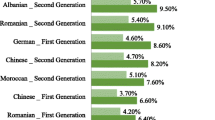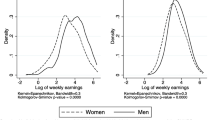Abstract
Employment discrimination may impede disadvantaged groups’ career advancement or, even worse, may hinder the groups’ access to desirable jobs. Moreover, discriminatory employment practices result in a huge loss of revenue to prejudiced firms. Due to the disastrous impacts of employment discrimination on the economic climate, we seek to measure taste-based employment discrimination between women and men in the Dominican Republic, Egypt, Hungary, Peru, UK, and Uruguay. To fulfill the aim, we estimate two regression models for the female and male workforce and then analyze differences between the coefficients of the explanatory variables in the models to examine the existence of taste-based employment discrimination caused by the tastes of customers and co-workers, and employers. Results indicate that the long-run taste-based employment discrimination between women and men has existed in the countries. In addition to taste-based discrimination, if employers select their workforce on the basis of productivity, the results demonstrate that statistical discrimination can occur in the countries.


Similar content being viewed by others
References
Allport, G.W. 1954. The Nature of Prejudice. Reading: Addison-Wesley.
Baars, J., and P. Scheepers. 1993. Theoretical and Methodological Foundations of the Authoritarian Personality. Journal of the History of the Behavioral Sciences 29 (4): 345–353.
Baumle, A.K., and M. Fossett. 2005. Statistical Discrimination in Employment: Its Practice, Conceptualization, and Implications for Public Policy. American Behavioral Scientist 48 (9): 1250–1274.
Becker, G.S. 1957. The Economics of Discrimination. Chicago: University of Chicago Press.
Berson, C. 2016. Local Labor Markets and Taste-Based Discrimination. IZA Journal of Labor Economics 5 (5): 1–29.
Bulow, J.I., and L.H. Summers. 1986. A Theory of Dual Labor Markets with Application to Industrial Policy, Discrimination, and Keynesian Unemployment. Journal of Labor Economics 4 (3): 376–414.
Burnette, J. 2012. Testing for Wage Discrimination in U.S. Manufacturing. US Census Bureau Center for Economic Studies Paper No. CES-WP-12-23.
Burns, C. 2012. The Costly Business of Discrimination: The Economic Costs of Discrimination and the Financial Benefits of Gay and Transgender Equality in the Workplace. Washington, DC: Center for American Progress.
Byron, R.A. 2010. Discrimination, Complexity, and the Public/Private Sector Question. Work and Occupations. 37 (4): 435–475.
Darity, W., and P. Mason. 1998. Evidence on Discrimination in Employment: Codes of Color, Codes of Gender. The Journal of Economic Perspectives 12 (2): 63–90.
Doeringer, P.B., and M.J. Piore. 1971. Internal Labor Markets and Manpower Analysis. Lexington, MA: D. C. Heath and company.
Droege, J. 2021. First impression biases in the performing arts: taste-based discrimination and the value of blind auditioning. Journal of Cultural Economics. 46 (3): 391–437.
Duguet, E. Parquet, L. Du., and P. Petit. 2018. Hiring Discrimination against Women: Distinguishing Taste Based Discrimination from Statistical Discrimination. Ffhalshs 01878917.
Fiske, S.T. 1998. Stereotyping, Prejudice, and Discrimination. In The Handbook of Social Psychology, vol. 2, 4th ed., ed. D.T. Gilbert, S.T. Fiske, and G. Lindzey, 357–411. New York: McGraw-Hill.
Gallen, Y. 2018. Motherhood and the Gender Productivity Gap. Working Papers 2018-091, Human Capital and Economic Opportunity Working Group.
Guryan, J., and K.K. Charles. 2013. Taste-Based or Statistical Discrimination: The Economics of Discrimination Returns to its Roots. The Economic Journal 123 (572): 417–432.
Hodson, G., and K. Dhont. 2015. The Person-Based Nature of Prejudice: Individual Difference Predictors of Intergroup Negativity. European Review of Social Psychology 26 (1): 1–42.
Im, K.S., M.H. Pesaran, and Y. Shin. 2003. Testing for Unit Roots in Heterogeneous Panels. Journal of Econometrics 115 (1): 53–74.
International Labor Office. 2003. Time for Equality at Work. International Labor Conference 91st Session.
Karmel, T., and M. Maclachlan. 1988. Occupational Sex Segregation—Increasing or Decreasing? Economic Record 64 (3): 187–195.
Koopmans, R., S. Veit, and R. Yemane. 2019. Taste or Statistics? A Correspondence Study of Ethnic, Racial and Religious Labour Market Discrimination in Germany. Ethnic and Racial Studies 42 (16): 233–252.
Kricheli-Katz, T. 2012. Choice, Discrimination, and the Motherhood Penalty. Law & Society Review 46 (3): 557–587.
Kruglanski, A.W., A. Pierro, L. Mannetti, and E. De Grada. 2006. Groups as Epistemic Providers: Need for Closure and the Unfolding of Group-Centrism. Psychological Review 113 (1): 84–100.
Madden, J.F. 1975. Discrimination—A Manifestation of Male Market Power? In Sex, Discrimination and the Division of Labor, ed. C.B. Lloyd. New York: Columbia University Press.
Pager, D., and H. Shepherd. 2008. The Sociology of Discrimination: Racial Discrimination in Employment, Housing, Credit, and Consumer Markets. Annual Review of Sociology 34: 181–209.
Pesaran, M.H., Y. Shin, and R. Smith. 1999. Pooled Mean Group Estimation of Dynamic Heterogeneous Panels. Journal of the American Statistical Association 94 (446): 621–634.
Pettigrew, T.F., and L.R. Tropp. 2006. A Meta-Analytic Test of Intergroup Contact Theory. Journal of Personality and Social Psychology 90 (5): 751–783.
Plickert, G., and J. Sterling. 2017. Gender Still Matters: Effects of Workplace Discrimination on Employment Schedules of Young Professionals. Laws 6 (4): 28.
Quillian, L. 1995. Prejudice as a Response to Perceived Group Threat: Population Composition and Anti-Immigrant and Racial Prejudice in Europe. American Sociological Review 60 (4): 586–611.
Scheepers, P., M. Gijsberts, and M. Coenders. 2002. Ethnic Exclusionism in European Countries: Public Opposition to Civil Rights for Legal Migrants as a Response to Perceived Ethnic Threat. European Sociological Review 18 (1): 17–34.
Sidanius, J., F. Pratto, C. van Laar, and S. Levin. 2004. Social Dominance Theory: Its Agenda and Method. Political Psychology 25 (6): 845–880.
Siddique, Z. 2011. Evidence on Caste Based Discrimination. Labour Economics 18 (1): 146–159.
Solow, R.M. 1956. A Contribution to the Theory of Economic Growth. The Quarterly Journal of Economics 70 (1): 65–94.
Thijssen, L. 2016. Taste-Based Versus Statistical Discrimination: Placing the Debate into Context. GEMM Project.
Wright, E., and J. F. Ermisch. 1990. Male-Female Wage-Differentials in Great Britain. Department of Economics, Birkbeck College, Discussion Paper.
Wright, E., and J.F. Ermisch. 1991. Gender Discrimination in the British Labour Market: A Reassessment. Economic Journal 101: 508–522.
Acknowledgements
The author would like to thank the editor and anonymous reviewers for their helpful and constructive comments, which have contributed significantly to improving the final version of this article.
Funding
This study was not funded by any source.
Author information
Authors and Affiliations
Corresponding author
Ethics declarations
Conflict of interest
The author declares that he has no conflict of interest.
Ethical Approval
This article does not contain any studies with human participants or animals performed by any authors.
Ethical Standard
The author complied with ethical standards. All the data used are from publicly available sources.
Additional information
Publisher's Note
Springer Nature remains neutral with regard to jurisdictional claims in published maps and institutional affiliations.
Rights and permissions
Springer Nature or its licensor holds exclusive rights to this article under a publishing agreement with the author(s) or other rightsholder(s); author self-archiving of the accepted manuscript version of this article is solely governed by the terms of such publishing agreement and applicable law.
About this article
Cite this article
Pirpour, H. Measuring Taste-Based Employment Discrimination Between Females and Males. Ind. J. Labour Econ. 65, 729–745 (2022). https://doi.org/10.1007/s41027-022-00394-6
Accepted:
Published:
Issue Date:
DOI: https://doi.org/10.1007/s41027-022-00394-6
Keywords
- Taste-based employment discrimination
- Employers
- Tastes
- Customers
- And co-workers
- Tastes
- Female and male workforce
- Statistical discrimination




